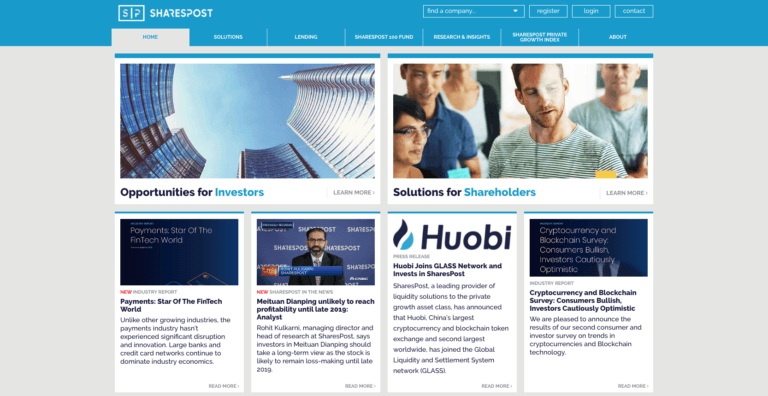San Francisco-based SharesPost is a leading provider of late-stage private company liquidity solutions and private capital markets research. Recently, at the Consensus: Singapore 2018 conference, we got the chance to speak with John Wu, the CEO of its Digital Assets Group.
Here’s a brief bio for John Wu:
Prior to SharesPost, John, who holds a Master of Business Administration from Harvard University and a Bachelor of Science from Cornell University, launched the SEGO fund to invest in digital currencies and securities; its predecessor fund, Sureview, was backed by the Blackstone Group. He was also previously a portfolio manager at Weiss Multi-Strategy Advisers, Kingdon Capital and Tiger Management. John is on the Advisory Boards of multiple blockchain companies.
As for the Digital Assets Group, its original name was the “Digital Securities Group”, and it was launched on 6 February 2018. The purpose of this group was “to bring security token issuers and investors into the SharesPost private marketplace.” Token issuers and investors would “use SharesPost’s existing Alternative Trading System to invest in ICO’s and trade in digital securities in compliance with U.S. securities laws.”
Investors “benefit from SharesPost’s proven transaction capabilities in unregistered securities and the digital custody capability of SharesPost’s Private Brokerage Accounts”; also, they are able “to view investment research and transaction data on leading token issuers.”
Here are the highlights of our interview with John:
CG: How did you get into crypto?
JW: So, I started investing in crypto on 2015. I’ve been a technology investor my entire career, both on the hedge fund side, as well as the private equity side. And, frankly, 2015, when I started investing, I just thought that there was a massive supply and demand imbalance. Back then, there were only a few cryptocurrencies, and Bitcoin was still only $200-$400.
CG: And so, how did you get involved with SharesPost?
JW: I’m running the Digital Assets Group at SharesPost, the parent company, which has been around for nine years. It’s the largest marketplace for private securities like, today, that’s Uber, Lyft, Airbnb, SpaceX… What I do is I’m using the broker-dealer license and the ATS [Alternative Trading System] license, and creating a crypto-related products marketplace for security tokens, an outsource compliance network, as well as asset management products, and research as you know from reading.
CG: How do you see the SEC regulate tokenized securities?
JW: So, first of all, I think this a great thing. Utility tokens in 2017 showed us the potential, but there was a lot of fraudulent and fraud-related activity. You need some sort of regulation to protect individuals who participate in these things, and security tokens, going forward, the infrastructure is being built right now, and part of that infrastructure is our marketplace at SharesPost.
Other people are building custodian solutions. Some other people are building tokenization technology to help on the primary issuance side. You need all three infrastructure plays to be ready… I think in 2019 when a lot of these projects are done or this building of infrastructure is done in 2018 and 2019, you’re going to see a large increase in issuance as well as trading in security tokens take place.
CG: So, do you envisage the amount of security token launches to be greater than the number of ICOs?
JW: So, not at the very beginning. But to give you an example, in 2017, between the mobile IPOs, regular IPOs, as well as private security venture capital funded, it was roughly over $350 billion of proceeds raised. If the security token world can replace 2% of that, it will be bigger than the utility token world in 2017.
So, when we get the infrastructure done, places like the one ShresPost is building and other places, you will see at least 2% of that market share from traditional IPO and venture funding come to this market, and it’ll be larger than the utility tokens.
CG: What do you see as the target market?
JW: I think, in the very beginning, that series A, B, and maybe C is the initial target market. But, at some point, when this becomes more commonplace, even series D and possible IPO candidates will want to do at least part of their fundraising in this format to gain access on a global scale.
CG: Is there going to be a legal backing with tokenized securities offerings?
JW: So, in the utility token world, their right is to use the network; they don’t have rights in terms of ownership. In the security token world, because of the regulation and because of all the enforcement and regulatory bodies that have help to create the rules, you will have rights of ownership. And that’s the difference between a security token and a utility token.
And ultimately, I think they’re two different paths. When projects want to create a network, they will go the utility token path if there is already a network in place and a product or service in place. Others who want to raise money will take the security token path. So, there will be two parallel paths, even though right now we talk about them interchangeably. Eventually, there’ll be two different paths.
CG: When do you see the bear market ending?
JW: We’ll start at the beginning. What happened in 2017? Why do we see this gigantic rally in 2017?
On the technology side, there were a lot of promises that scaling and all these other great things would happen. There was also promise on the capital flow side that all this institutional demand would come in and want to buy crypto.
So why is 2018 what it is? Neither of these things has happened yet. Scaling is taking longer, and the institutions who want to invest can’t until the infrastructure we talked about is built. So, I see progress in technology and infrastructure being built in 2018, and so 2019 will be a much better year.
Featured Image Courtesy of SharesPost









